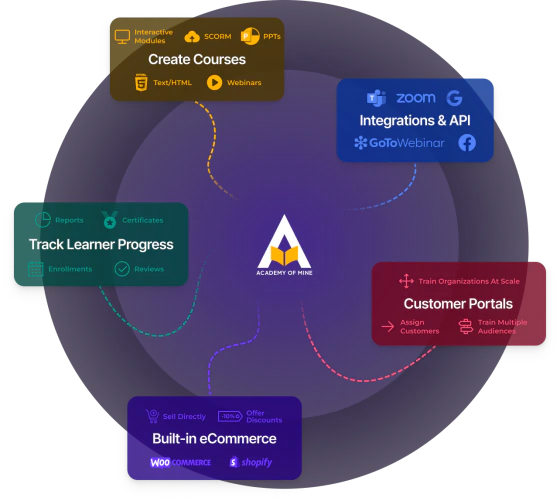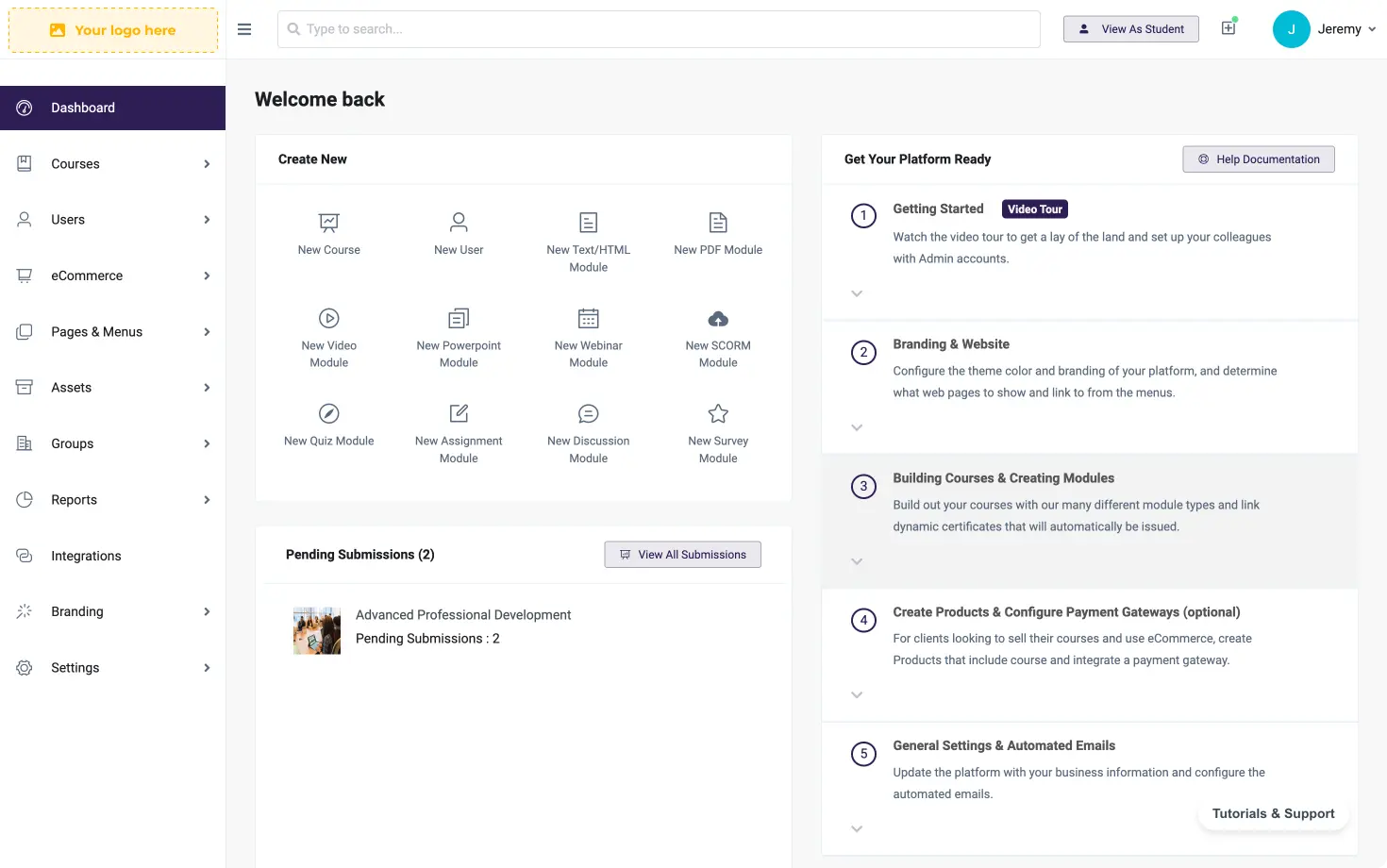eLearning, Learning Management System
5 Reasons Your Organization Needs An LMS

Did you know there’s a way you could onboard new employees, retrain current employees, sell eLearning courses to customers, or even train partners all under one roof?
It’s called an LMS and it can transform your business, both internally and externally.
LMSs are a software application designed to streamline eLearning by utilizing analytical data, third-party integrations, reporting tools, and automation. An LMS can be cloud-based or locally hosted, and it makes creating, delivering, and maintaining learning and development programs simple for organizations of all sizes.
It doesn’t take a rocket scientist to understand that properly trained employees are more profitable than untrained employees. Unfortunately, effective training can be expensive, especially if your organization is expanding at a rapid pace. So, whether you are already familiar with LMSs or are just now hearing about them for the first time, after reading this article, you will be able to better understand if using one would make sense for your organization!
Here are some key features of an LMS:
- Course Management
- Blended Learning
- E-Commerce
- Assessment Tools
- Instructor-Led Training (ILT)
If you are unfamiliar with LMS platforms, or curious about what features to look for, check out our complete guide on the 19 essential features of an LMS.
Increase Training Effectiveness
Most training systems are created one time, updated infrequently (if ever), and require a live-instructor to be involved. This means three main things:.
- Customers (internal and external) will be taking a training course that over time becomes irrelevant because it contains outdated information.
- Defining success in a course and tracking user progress can be hard to measure.
- Your organization’s training offering can vary in quality since it depends heavily on a live instructor
Using an LMS, organizations can update current training programs individually and add/subtract to their course catalogs whenever they see fit. In addition, these features ensure that all employees getting trained internally, and customers getting trained externally, are in good hands when it comes to the reliability and quality of their training. Using an LMS is also an excellent way to implement ongoing training for employees and third-party bodies (customers, partners, etc.)
Your company doesn’t have to worry about training inconsistencies with an LMS since course admins have complete control over how much a course relies on live training or not. In other words, it’s up to an organization whether they want a course to be composed of mainly self-paced learning, or for it to deploy more of a blended learning approach, incorporating some real-time learning using video conferencing platforms such as Zoom and Microsoft Teams.
Thanks to reporting and assessment tools built into an LMS, defining success in a course and tracking users’ progress is simple and leaves little to no room for error. Equally important, the grading of tests, quizzes, and other assessments can easily be automated, to guarantee accuracy and save time.
Streamline Bulk Training
Internal and external training is a straightforward process if you have thoughtful leaders and well-structured management. Unfortunately for larger enterprises, training more than one organization at a time (bulk training) can seem impossible without the right system in place.
Does the term “bulk training” scare you and your organization? If you answered yes to this or were skeptical to answer at all, then you might want to consider using an LMS.
TeamHealth is the leading physician practice in the U.S., and they use AOM’s LMS to deliver lean-based emergency department operations education to both individual medical professionals as well as healthcare organizations. They train multiple different organizations (5,000+ people) and their own employees using only one LMS.
LMSs give admins the option to bulk import users, which makes the process of onboarding external enterprises or separating your internal departments’ training programs less complicated.
In fact, by utilizing grouping, organizations can separate their client’s course catalogs and each organization’s visual branding. For example; TeamHealth uses its LMS to train not only its employees but also many other third-party organizations (external customers). Moreover, TeamHealth employees do not have access to the same training courses as their external customers, and vice versa.
You need to train multiple large organizations both internally and externally using one effective system…YOU NEED AN LMS!
Reduce The Cost of Training
Training is expensive. On the bright side, if you nail your organization’s internal training program, your employees become more competent and productive, which makes your organization more profitable.
There are certain unavoidable expenses associated with in-person training like the compensation of onsite instructors, printed training materials, company subsidized travel expenses, and sometimes larger organizations need to rent space for training seminars.
We aren’t saying you should completely eliminate the use of live instructors for training, just that you should be realistic about alternatives.
Besides, many organizations find training employees remotely using live video conference platforms like zoom, to yield very similar results at a fraction of the price. LMSs also reduce the cost of training is because of a feature called blended learning, which allows organizations to build courses using a combination of self-paced learning (asynchronous) and real-time learning (synchronous).
Examples of self-paced learning:
- Premade videos
- Documents and interactive worksheets
- Pdf’s
- Online quizzes
- Online exams
Examples of real-time learning:
- Webinars
- 1 on 1 video sessions
- Online seminars
- Learning workshops
- Small group classes
Blended learning also makes implementing continuous training and training in bulk simple and easily scalable.
Combine Fragmented Systems
You know how your company has different departments, and each department uses different software applications to get their jobs done? For example, Sales uses HubSpot, Marketing uses Google Analytics and Google Search Console, and HR uses Zoom and Microsoft Teams, each team loves their tools but their tools don’t share data with each other.
When your organization’s tools share data with each other, you can eliminate cross-departmental communication inconsistencies.
Aside from creating communication issues, tools that don’t integrate together into one system and share data make training internally and externally much less efficient.
What if we told you, you could use a system that would allow for various software applications to share data and work together (seriously, this exists).
Integrations are the word you’re looking for, and they are a huge part of LMSs. Using an LMS makes providing seamless training experiences to your employees and customers a walk in the park. So, stop wasting time logging into multiple solutions to showcase one thing to your customers, and start using an LMS to fully integrate third-party applications in an all-inclusive system.
Monetize eLearning Course
According to the National Center for Educational Statistics, in 2018-2019, public institutions generated $416 billion in total revenues. Universities monetize their courses so why shouldn’t your organization?
External training, otherwise known as offering eLearning courses or programs to a third party, is a huge industry. Regardless if you’re going to sell courses to your audience as a product or as an add-on to a service, the revenue potential is undeniable. The best part is, your organization might already have training courses that you’re offering internally, which could be slightly altered to match an external audience.
In other words, you are leaving serious money on the table.
Similarly, if you’re interested in offering eLearning courses externally, but don’t want to abandon your internal employee training system, you have nothing to worry about. LMSs have a feature called Grouping, which allows course admins to separate internal and external training courses, keeping both your employees and third-party customers happy!
All said and done…
If you made it this far, you see the ways an LMS can transform your business. Whether you need to streamline your employee training, educate your customers, or anything in between, an LMS is an extremely powerful tool.
Not all LMSs are the same though. That’s why we’ve written a complete guide that covers 19 essential features of an LMS!
If you need some help finding the right LMS, AOM is here to provide expert guidance – we have 600+ customers in many industries, all the way from Healthcare and Insurance, to HR and Finance!

